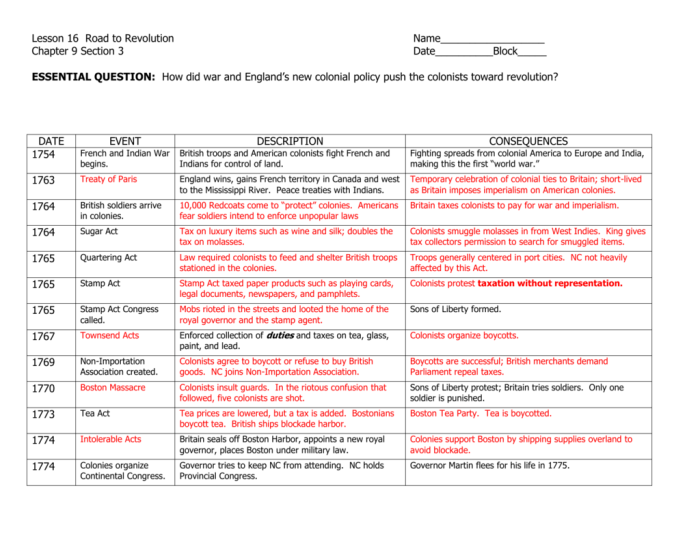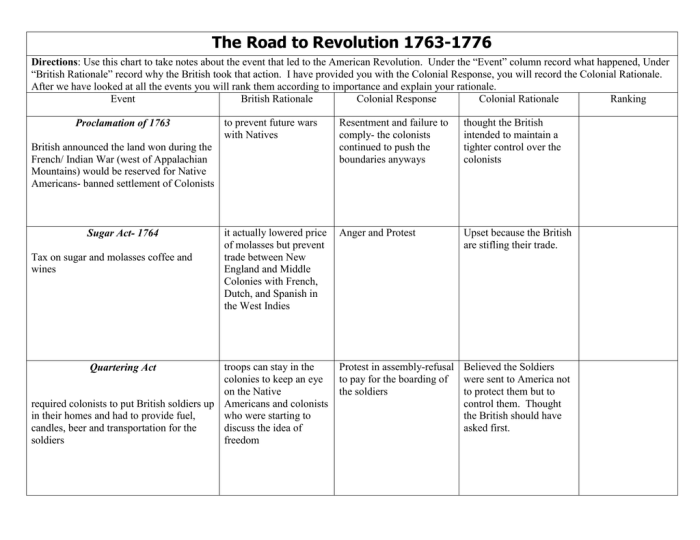Embark on an enlightening journey with our comprehensive Road to Revolution Worksheet Answer Key, meticulously crafted to unlock the complexities of the American Revolution. Immerse yourself in the historical context, stages, key figures, and lasting impact of this pivotal event, gaining invaluable insights into its profound significance.
This guidebook provides a panoramic view of the American Revolution, exploring the underlying causes, pivotal moments, and transformative consequences that shaped a nation and continue to resonate in contemporary society.
Historical Context of Revolution: Road To Revolution Worksheet Answer Key

Revolutions are transformative events that involve the overthrow of an established political order and the establishment of a new one. Throughout history, revolutions have played a pivotal role in shaping the course of human civilization. Some of the most significant revolutions include the French Revolution, the American Revolution, and the Russian Revolution.
These revolutions were driven by a complex interplay of factors, including economic inequality, political oppression, and social unrest.
Causes and Motivations behind Revolutions
Revolutions are often sparked by a combination of economic, political, and social grievances. Economic inequality, for example, can lead to widespread discontent and a desire for a more just distribution of resources. Political oppression, such as the denial of basic rights and freedoms, can also be a major catalyst for revolution.
Social unrest, caused by factors such as rapid urbanization and cultural change, can also contribute to revolutionary sentiment.
Stages of Revolution
Revolutions typically progress through a series of stages, from inception to outcome. The initial stage is characterized by the emergence of grievances and the formation of opposition groups. As the grievances intensify, the opposition groups may begin to organize and mobilize.
This can lead to protests, strikes, and other forms of civil disobedience. If the government is unable to address the grievances, the revolution may escalate into violence. The final stage of a revolution is the overthrow of the established order and the establishment of a new government.
Factors Influencing the Progression of a Revolution
The progression of a revolution is influenced by a number of factors, including the level of government repression, the strength of the opposition movement, and the support of the population. If the government is able to effectively suppress dissent, the revolution may be quickly quashed.
However, if the opposition movement is well-organized and has the support of the population, it may be able to overcome government resistance and achieve its goals.
Key Figures and Movements
Revolutions are often led by charismatic figures who inspire and mobilize the masses. These figures may come from a variety of backgrounds, but they often share a common vision for a better future. In the American Revolution, key figures included George Washington, Thomas Jefferson, and Benjamin Franklin.
These men played a vital role in organizing the Continental Army, drafting the Declaration of Independence, and securing foreign aid.
Strategies and Tactics Used by Revolutionaries
Revolutionaries employ a variety of strategies and tactics to achieve their goals. These may include propaganda, civil disobedience, and violence. Propaganda is used to spread the revolutionary message and gain support for the cause. Civil disobedience is used to disrupt the functioning of the government and economy.
Violence is sometimes used as a last resort when other methods have failed.
Impact of Revolution
Revolutions can have a profound impact on societies, both in the short term and the long term. In the short term, revolutions can lead to violence, instability, and economic disruption. However, in the long term, revolutions can also lead to positive changes, such as the establishment of more just and democratic governments.
Political, Social, and Economic Changes Brought About by the American Revolution
The American Revolution led to a number of significant political, social, and economic changes. Politically, the revolution established the United States as a republic and guaranteed its citizens certain fundamental rights and freedoms. Socially, the revolution led to the abolition of slavery and the expansion of educational opportunities.
Economically, the revolution led to the creation of a more open and prosperous economy.
Modern Relevance

The American Revolution continues to have relevance for contemporary society. The principles of liberty, equality, and democracy that were enshrined in the Declaration of Independence and the Constitution continue to inspire people around the world. The American Revolution also serves as a reminder of the power of the people to overthrow oppressive governments and create a better future.
Lessons that Can Be Learned from the Revolutionary Process, Road to revolution worksheet answer key
The American Revolution offers a number of valuable lessons for contemporary society. One lesson is that revolutions are often sparked by a combination of economic, political, and social grievances. Another lesson is that revolutions can be successful if the opposition movement is well-organized and has the support of the population.
Finally, the American Revolution teaches us that revolutions can lead to positive changes, such as the establishment of more just and democratic governments.
Essential FAQs
What are the key stages of a revolution?
Revolutions typically progress through distinct stages, including inception, escalation, crisis, resolution, and aftermath.
Who were some of the most influential figures in the American Revolution?
George Washington, Thomas Jefferson, Benjamin Franklin, and Patrick Henry played pivotal roles in the American Revolution.
What were the long-term effects of the American Revolution?
The American Revolution led to the establishment of the United States, the spread of democratic ideals, and the transformation of global power dynamics.
